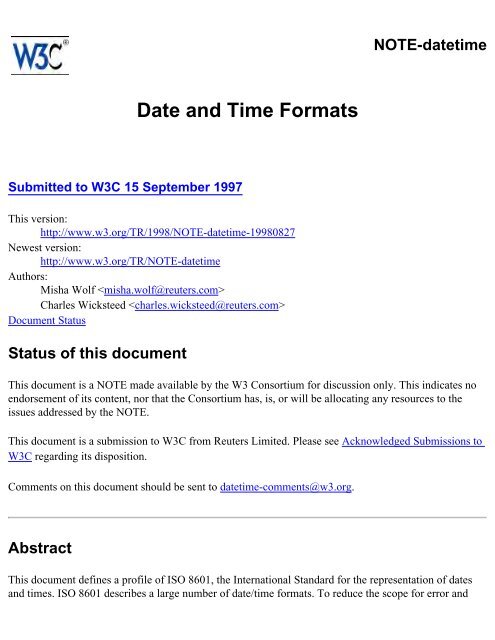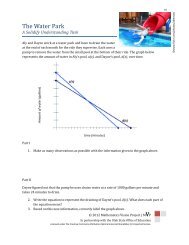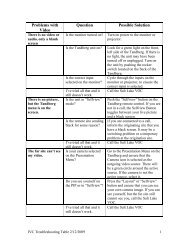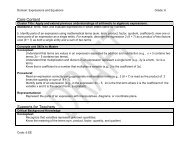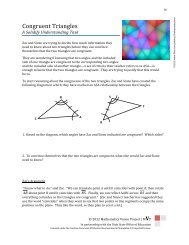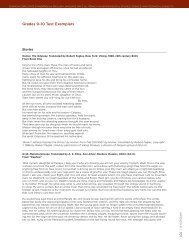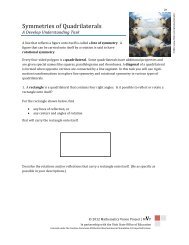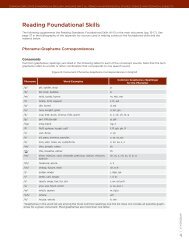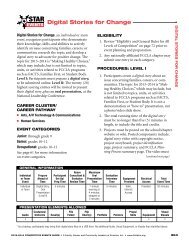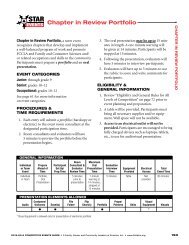Date and Time Formats
Date and Time Formats
Date and Time Formats
You also want an ePaper? Increase the reach of your titles
YUMPU automatically turns print PDFs into web optimized ePapers that Google loves.
NOTE-datetime<br />
<strong>Date</strong> <strong>and</strong> <strong>Time</strong> <strong>Formats</strong><br />
Submitted to W3C 15 September 1997<br />
This version:<br />
http://www.w3.org/TR/1998/NOTE-datetime-19980827<br />
Newest version:<br />
http://www.w3.org/TR/NOTE-datetime<br />
Authors:<br />
Misha Wolf <br />
Charles Wicksteed <br />
Document Status<br />
Status of this document<br />
This document is a NOTE made available by the W3 Consortium for discussion only. This indicates no<br />
endorsement of its content, nor that the Consortium has, is, or will be allocating any resources to the<br />
issues addressed by the NOTE.<br />
This document is a submission to W3C from Reuters Limited. Please see Acknowledged Submissions to<br />
W3C regarding its disposition.<br />
Comments on this document should be sent to datetime-comments@w3.org.<br />
Abstract<br />
This document defines a profile of ISO 8601, the International St<strong>and</strong>ard for the representation of dates<br />
<strong>and</strong> times. ISO 8601 describes a large number of date/time formats. To reduce the scope for error <strong>and</strong>
the complexity of software, it is useful to restrict the supported formats to a small number. This profile<br />
defines a few date/time formats, likely to satisfy most requirements.<br />
Introduction<br />
The International St<strong>and</strong>ard for the representation of dates <strong>and</strong> times is ISO 8601. Its full reference<br />
number is ISO 8601 : 1988 (E), <strong>and</strong> its title is "Data elements <strong>and</strong> interchange formats - Information<br />
interchange - Representation of dates <strong>and</strong> times". A discussion of ISO 8601 has been written by Markus<br />
Kuhn.<br />
ISO 8601 describes a large number of date/time formats. For example it defines Basic Format, without<br />
punctuation, <strong>and</strong> Extended Format, with punctuation, <strong>and</strong> it allows elements to be omitted. This profile<br />
defines a restricted range of formats, all of which are valid ISO 8601 dates <strong>and</strong> times. The aim is to<br />
simplify the use of ISO 8601 in World Wide Web-related st<strong>and</strong>ards, <strong>and</strong> to avoid the need for the<br />
developers <strong>and</strong> users of these st<strong>and</strong>ards to obtain copies of ISO 8601 itself.<br />
A particular problem with ISO 8601 is that it allows the century to be omitted from years, which is<br />
likely to cause trouble as we approach the year 2000. This profile avoids the problem by expressing the<br />
year as four digits in all cases.<br />
This profile may be adopted by st<strong>and</strong>ards which require an unambiguous representation of dates <strong>and</strong><br />
times. As different st<strong>and</strong>ards have their own requirements regarding granularity <strong>and</strong> flexibility, this<br />
profile offers a number of options. An adopting st<strong>and</strong>ard must specify which of these options it permits.<br />
<strong>Formats</strong><br />
Different st<strong>and</strong>ards may need different levels of granularity in the date <strong>and</strong> time, so this profile defines<br />
six levels. St<strong>and</strong>ards that reference this profile should specify one or more of these granularities. If a<br />
given st<strong>and</strong>ard allows more than one granularity, it should specify the meaning of the dates <strong>and</strong> times<br />
with reduced precision, for example, the result of comparing two dates with different precisions.<br />
The formats are as follows. Exactly the components shown here must be present, with exactly this<br />
punctuation. Note that the "T" appears literally in the string, to indicate the beginning of the time<br />
element, as specified in ISO 8601.<br />
Year:<br />
YYYY (eg 1997)
Year <strong>and</strong> month:<br />
YYYY-MM (eg 1997-07)<br />
Complete date:<br />
YYYY-MM-DD (eg 1997-07-16)<br />
Complete date plus hours <strong>and</strong> minutes:<br />
YYYY-MM-DDThh:mmTZD (eg 1997-07-16T19:20+01:00)<br />
Complete date plus hours, minutes <strong>and</strong> seconds:<br />
YYYY-MM-DDThh:mm:ssTZD (eg 1997-07-16T19:20:30+01:00)<br />
Complete date plus hours, minutes, seconds <strong>and</strong> a decimal fraction<br />
of a<br />
second<br />
YYYY-MM-DDThh:mm:ss.sTZD (eg 1997-07-16T19:20:30.45+01:00)<br />
where:<br />
YYYY = four-digit year<br />
MM = two-digit month (01=January, etc.)<br />
DD = two-digit day of month (01 through 31)<br />
hh = two digits of hour (00 through 23) (am/pm NOT allowed)<br />
mm = two digits of minute (00 through 59)<br />
ss = two digits of second (00 through 59)<br />
s = one or more digits representing a decimal fraction of a<br />
second<br />
TZD = time zone designator (Z or +hh:mm or -hh:mm)<br />
This profile does not specify how many digits may be used to represent the decimal fraction of a second.<br />
An adopting st<strong>and</strong>ard that permits fractions of a second must specify both the minimum number of digits<br />
(a number greater than or equal to one) <strong>and</strong> the maximum number of digits (the maximum may be stated<br />
to be "unlimited").<br />
This profile defines two ways of h<strong>and</strong>ling time zone offsets:<br />
1. <strong>Time</strong>s are expressed in UTC (Coordinated Universal <strong>Time</strong>), with a special UTC designator ("Z").<br />
2. <strong>Time</strong>s are expressed in local time, together with a time zone offset in hours <strong>and</strong> minutes. A time<br />
zone offset of "+hh:mm" indicates that the date/time uses a local time zone which is "hh" hours<br />
<strong>and</strong> "mm" minutes ahead of UTC. A time zone offset of "-hh:mm" indicates that the date/time<br />
uses a local time zone which is "hh" hours <strong>and</strong> "mm" minutes behind UTC.<br />
A st<strong>and</strong>ard referencing this profile should permit one or both of these ways of h<strong>and</strong>ling time zone offsets.
Examples<br />
1994-11-05T08:15:30-05:00 corresponds to November 5, 1994, 8:15:30 am, US Eastern<br />
St<strong>and</strong>ard <strong>Time</strong>.<br />
1994-11-05T13:15:30Z corresponds to the same instant.<br />
Acknowledgments<br />
This document draws on Chris Newman's Internet Draft "<strong>Date</strong> <strong>and</strong> <strong>Time</strong> on the Internet" (draft-newm<strong>and</strong>atetime-01.txt).


